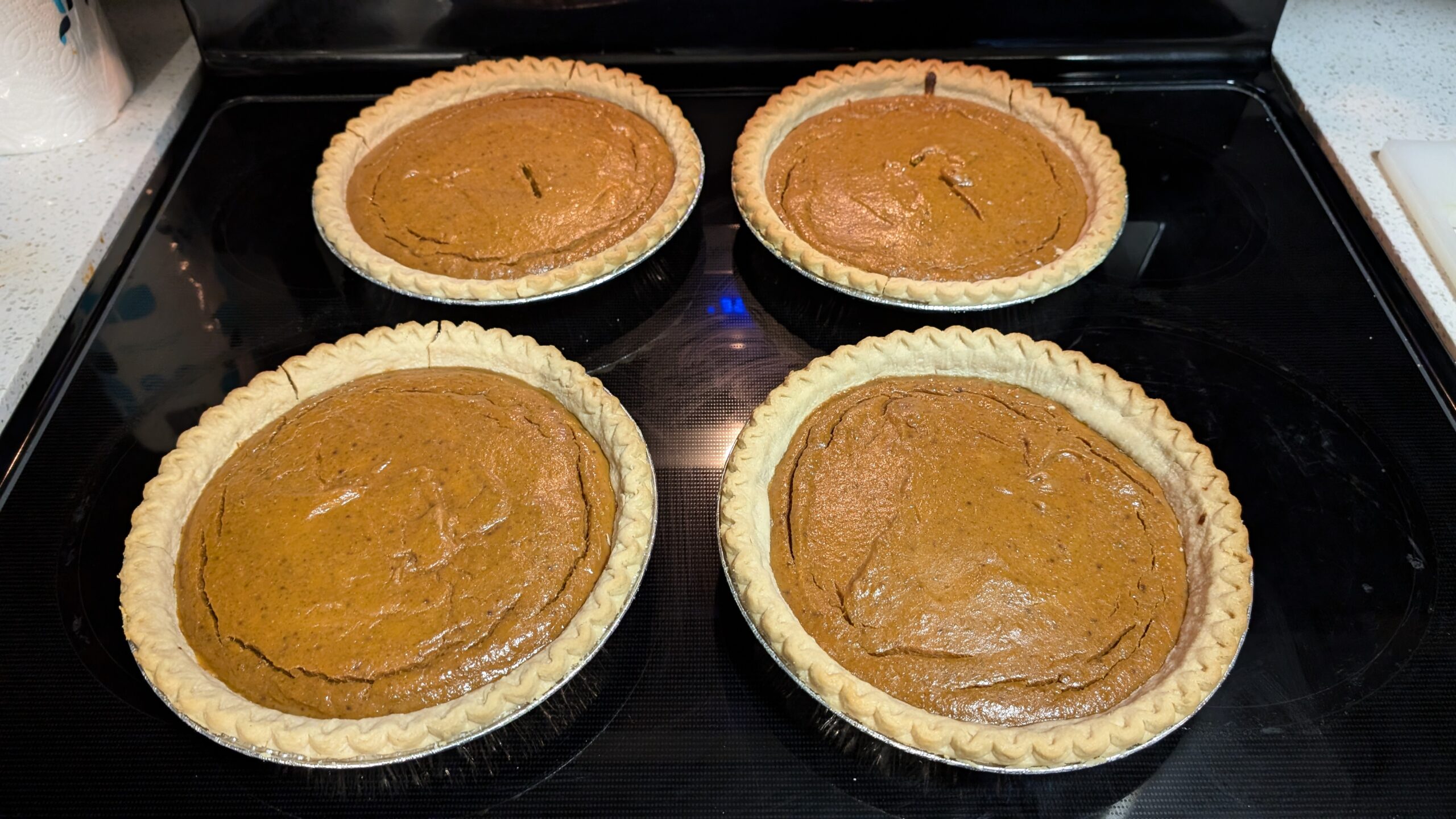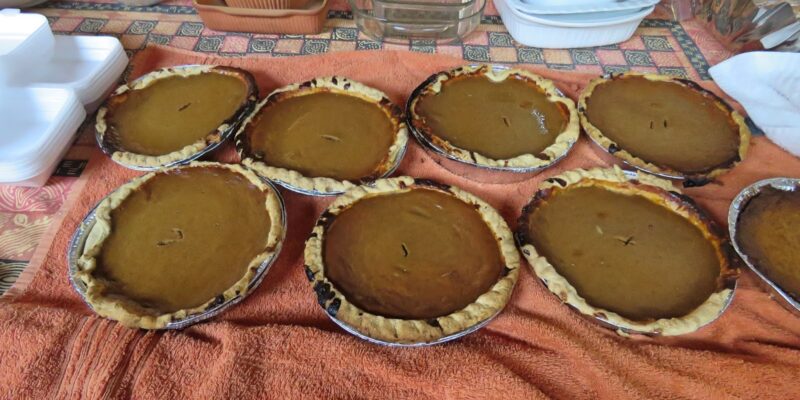 |
| Here were my eight less-than-perfect pumpkin pies, made on a 104F, 40C day, for a Thanksgiving dinner celebrated in the bush on November 17, 2018. It was impossible to roll the homemade dough in the heat and humidity. Thus, I called it a “Pie day from hell.” At the bottom right is a low-carb pumpkin pie made with an almond flour crust for Louise and Danie. Today’s four pies will look much better. See the post here. |
This morning, I managed to walk down the corridor to the elevator bank and make my way to the front desk to pick up a package from Amazon. Then, after I returned to our room, I proceeded to make the four pumpkin pies for Tom, which are now being baked in the oven. This felt like quite an accomplishment.
I didn’t make the crust without a food processor. Instead, I bought the best-prepared crusts from Whole Foods. Hopefully, Tom will enjoy the pies. I’ll leave two pies out and freeze the other two for Tom to enjoy when he chooses. Cooked pumpkin pies freeze well but only for about one month.
We won’t be making a typical Thanksgiving dinner this year, which we haven’t done except when we’ve had guests over the years. Although having a vast array of delicious dishes would be enjoyable, we don’t have the appropriate serving dishes and kitchen utensils to prepare such a meal. Plus, it would be too much work for me now.
As soon as Tom’s pies are done, I’ll make my keto cheese pie, which I haven’t made since we were in South Africa in April 2023. Whenever I make this pie, I think of Louise and Danie, who love it. When it’s done, I take a photo and send it to them. Recently Louise wrote to me asking if I’d make the pie for them when we arrived. Of course, I’d be thrilled to do so!

Pumpkin pie has a long history, especially in the US.
Pumpkin pie, a classic dessert closely associated with autumn and Thanksgiving in the United States, has a rich history that spans centuries and continents. Its story begins long before the Pilgrims set foot on American soil, rooted in the traditions of Native Americans and European settlers.
Native American Origins
The indigenous peoples of North America were cultivating pumpkins and other squash for thousands of years before European settlers arrived. They used these hardy, versatile gourds for both food and practical purposes. Pumpkins were roasted, boiled, or mashed, but the idea of transforming pumpkin into a sweet dessert wouldn’t emerge until later.
Early European Influence
When European settlers arrived in North America in the 1600s, they brought with them a taste for meat pies and custards. However, they found pumpkins a valuable substitute for ingredients they were familiar with back in Europe. Instead of making the pies we think of today, early settlers would hollow out pumpkins, fill them with milk, honey, and spices, and bake them whole in the ashes of a fire. These early “pumpkin pies” were more like a pudding baked inside the shell of a pumpkin, and the use of sugar or spices varied depending on what was available.
The Birth of Modern Pumpkin Pie
The pumpkin pie we know today, with its flaky crust and spiced filling, began to take shape during the 17th and 18th centuries as colonial cooks combined Old World techniques with New World ingredients. The first recorded recipes resembling modern pumpkin pie appeared in English cookbooks. The 1670 cookbook The Gentlewoman’s Companion contains a recipe for “Pumpion Pye,” which involved layering pumpkin with apples, spices, and sugar in a pastry crust. By the late 18th century, recipes had spread throughout New England, where pumpkin pies became a regional specialty.
Pumpkin Pie and Thanksgiving
By the early 19th century, pumpkin pie had become strongly associated with the fall harvest and Thanksgiving. Sarah Josepha Hale, often credited with helping to establish Thanksgiving as a national holiday, popularized pumpkin pie in her 1827 novel Northwood, in which she described a Thanksgiving meal that featured the now-iconic dessert.
When Abraham Lincoln declared Thanksgiving a national holiday in 1863, pumpkin pie was firmly embedded in American culture. Its presence at Thanksgiving dinner cemented its status as an American tradition and has remained a beloved part of the holiday ever since.
Modern Day Popularity
Today, pumpkin pie is as popular as ever. Canned pumpkin, first introduced in the 1920s, made it easier and quicker to prepare, contributing to its widespread consumption. While many families still make their pies from scratch, the availability of ready-made pie crusts, pumpkin pie filling, and even pre-baked pies has kept the tradition alive in an era of convenience.
Though variations exist—some prefer to tweak the spices or add a touch of maple syrup—the core ingredients of pumpkin puree, sugar, and warming spices like cinnamon, ginger, and nutmeg remain constant. It symbolizes warmth, comfort, and togetherness, particularly during the colder months when families gather for the holidays.
From humble Native American beginnings to a dessert that graces millions of tables each year, pumpkin pie has become a cherished tradition that’s evolved with the times but remains a delicious celebration of fall’s bounty.
Be well.
Photo from ten years ago today, October 3, 2014:
 |
| Was this a houseboat, island, or floating property we spotted in Kona, Hawaii, ten years ago? For more photos, please click here. |

